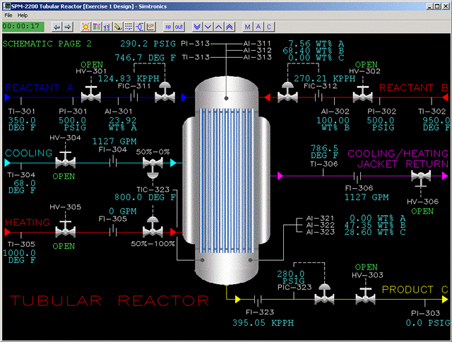

Process Description
The SPM-2200 Tubular Reactor Process Simulation can be configured to react any two gases. The reaction can be exothermic or endothermic. The default configuration catalytically reacts ethylene (reactant A) with benzene (reactant B), an exothermic reaction, to produce ethylbenzene (product C), an intermediate chemical used in the manufacture of styrene monomer. There are no side or competing reactions simulated.
Reactants A and B are fed to the inlet of the tubular reactor where they are completely mixed before entering the catalyst packed reactor tubes.
Reactant A feedstock is assumed to come from a typical refinery FCC. Consequently, there is a substantial concentration of inerts in the feed. Since the reaction is highly exothermic, the inerts serve to dilute the feed and aid in preventing a reactor run-away.
Reactant B feedstock is assumed to be of the highest available industrial grade and is therefore effectively 100% pure for the purposes of this simulation.
The reactor tubes are sized to convert all of reactant A to product. The inlet molar ratio of reactant B to reactant A is maintained at 3.25 to 1.
The product stream is purified downstream of the reactor through a
series of distillation columns. The inerts are vented, recompressed, and
used as a fuel gas elsewhere in the plant. Reactant B is recovered,
purified, and recycled back to the reactor. The purification of the
product stream is outside the scope of this simulation.
Instrumentation
The reactant A feed flow loop is outfitted with a composition analyzer (AI-301) that measures weight percent A, the balance being inerts. The supply temperature and pressure are indicated by TI-301 and PI-301 respectively. The feed block valve can be opened and closed with switch HV-301. Reactant A flow to the reactor is modulated by flow controller FIC-311.
The reactant B feed flow loop is outfitted with a composition analyzer (AI-302) that measures weight percent B, the balance being inerts. The supply temperature and pressure are indicated by TI-302 and PI-302 respectively. The feed block valve can be opened and closed with switch HV-302. Reactant B flow to the reactor is modulated by flow controller FIC-312.
Inlet and outlet reactor temperatures are indicated by TI-311 and TIC-323 respectively. TIC-323 controls the outlet reactor temperature by modulating the cooling and heating flows to the reactor jacket, indicated by FI-304 and FI-305 respectively. Total flow through the reactor jacket is indicated by FI-306. Cooling flow inlet temperature is indicated by TI-304, heating flow inlet temperature is indicated by TI-305, and reactor jacket outlet flow temperature is indicated by TI-306. The cooling flow block valve can be opened and closed with switch HV-304, the heating flow block valve can be opened and closed with switch HV-305, and the reactor jacket effluent block valve can be opened and closed with switch HV-306.
The reactor inlet pressure is indicated by PI-313. Reactor pressure is controlled by PIC-323 which modulates the reactor effluent flow, indicated by FI-323. The reactor effluent block valve can be opened and closed with switch HV-303. Product discharge pressure is indicated by PI-303.
Reactor inlet compositions are indicated by AI-311 (WT% A), AI-312 (WT% B), and AI-313 (WT% C). Reactor outlet compositions are indicated by AI-321 (WT% A), AI-322 (WT% B), and AI-323 (WT% C). Inerts compositions can be determined by difference.